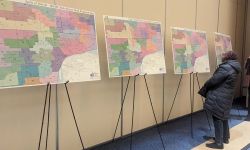Democrats, GOP could split Michigan Senate under new redistricting maps

Oct. 15: Michigan redistricting panel’s maps spark racial backlash, fairness questions
Oct. 11: Michigan redistricting drafts could make state Senate a toss-up
Oct. 11: Michigan congressional redistricting drafts are done. Few incumbents are safe
Oct. 11: Republicans have edge, but Michigan House drafts include plenty of surprises
LANSING — Members of Michigan’s redistricting commission have agreed in principle to new state Senate boundaries that would equally split seats among Democrats and Republicans.
Each party would be favored in 19 seats in the 38-seat Senate, under a draft drawn Monday that was tweaked to be fairer to both parties and protect minority votes.
Current districts favor Republicans 22-16, even though Michigan leans Democratic in statewide elections. Critics say that is the result of gerrymandering, which prompted voters in 2018 to create a bipartisan panel to draw political districts after the decennial census.
That group, the 13-member Michigan Independent Redistricting Commission, could vote on the Senate district maps in the next few days. Proposed congressional and state House maps also may be reviewed and adjusted this week.
New Senate maps approach partisan parity
Source: Bridge Michigan analysis of maps provided by the Michigan Independent Citizens Redistricting Commission
Before final approval late this year, the commission plans five public hearings across the state to hear from the public, before making additional adjustments.
The new Senate proposal emerged after earlier maps from the commission would have given Republicans a two-seat advantage in the Senate. That drew concern from Democrats and others, prompting the commission to try to make the maps fairer to both parties.
Districts represent 252,222 to 275,095 people. Among the highlights of the new proposal:
- Kalamazoo is in one district (21), as is Ann Arbor (27), while Grand Rapids (23 and 24) and Lansing are in two (30 and 32). All lean Democratic.
- Saginaw, Midland and Bay City would be in one district that leans narrowly Democratic. The current boundaries have each city in different districts, all of which are currently represented by Republicans.
- Minorities would be the majority in districts 14 (Southfield, Pontiac, Bloomfield Township and Bloomfield Hills), 6 (Detroit and parts of Warren and Sterling Heights), 8 (Detroit, Hamtramck, Hazel Park, Madison Heights), 9 (Detroit, Redford, parts of Livonia and Farmington Hills) and 17 (southwest Detroit and several Downriver communities.)
- While existing districts generally adhere to county boundaries, the new proposal has six districts stretching from Wayne and into Oakland or Macomb counties.Two proposed districts now include parts of both Oakland and Macomb counties.
- The maps split some big cities like Livonia and Sterling Heights — which are now both in one district apiece — to maintain “communities of interest” in one district, like the Bangladeshi community in Hamtramck and Warren. Sterling Heights is split into three districts, while Livonia is in two.
The commission weighed several factors in creating the districts, including the “efficiency gap,”which attempts to measure whether voters are “packed” by political parties into districts to waste” votes.”
A gap of zero means districts are evenly split by Democrats and Republicans. Earlier versions of the maps had gaps of 12 percent or higher, while the new one split that in half to 6.3 percent in favor of Republicans.
Related:
- Republicans hold on power in Lansing could grow with redistricting
- Michigan’s next big election fight: absentee ballot signatures
- Few incumbents are safe in Michigan’s draft congressional district maps
- GOP still holds edge in Michigan map drafts, but Democrats could gain seats
- Michigan redistricting panel to miss maps deadline. More lawsuits may follow.
Fairness is one consideration, but commissioners said they are also trying to comply with the Voting Rights Act to preserve the rights of minority voters by creating districts in which they are the majority.
Maintaining those districts under new Senate maps was a sticking point during Monday’s negotiations.
Bruce Adelson, the commission’s voting rights attorney, recommended commissioners “unpack,” or move Black voters, from districts in the Detroit area.
He said the U.S. Supreme Court had made it clear that if there are more minority voters than what is needed to elect their candidate of choice, that could be in violation of the Voting Rights Act.
The commission’s legal team recommended the commission to bring the number of African Americans within the voting age population down to about 35 percent in the Detroit districts, from the current percentage which ranges from 44 percent to 48 percent.
This made commissioners uneasy.
Anthony Eid, an independent from Orchard Lake in Oakland County, said he was “increasingly uncomfortable with this direction.”
Eid used as an example proposed district 17, which would include Ecorse, Highland Park and River Rouge. That district would be composed of 44 percent white voters, 38 percent Black voters and 19 percent Hispanic voters.
“If you have a primary election where there's two Black candidates and a white candidate, how is it that the candidate of choice is actually going to get elected?” Eid asked.
“I understand that in the general election, yes, all of these districts that we draw are going to be Democratic districts, but that's not where the choice actually happens in these areas.”
Commissioner Juanita Curry, a Democrat from Detroit, vouched for increasing the recommended number of Black voters in districts, arguing the panel should take voter turnout — rather than eligible voters — into consideration.
Adelson doubled down that drawing districts was a “data-driven legal process.”
“It's not an anecdotal process, it's not a process where we look at something and make conclusive decisions,” Adelson said.
See what new members are saying about why they donated to Bridge Michigan:
- “In order for this information to be accurate and unbiased it must be underwritten by its readers, not by special interests.” - Larry S.
- “Not many other media sources report on the topics Bridge does.” - Susan B.
- “Your journalism is outstanding and rare these days.” - Mark S.
If you want to ensure the future of nonpartisan, nonprofit Michigan journalism, please become a member today. You, too, will be asked why you donated and maybe we'll feature your quote next time!




